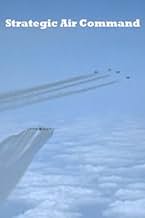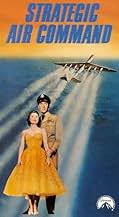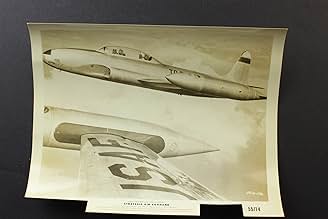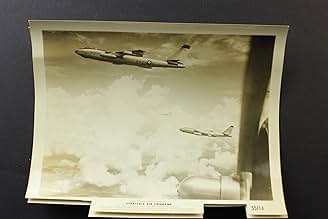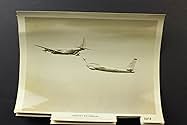IMDb RATING
6.3/10
4.2K
YOUR RATING
An ex-pilot and current baseballer is recalled into the U.S. Air Force and assumes an increasingly important role in Cold War deterrence.An ex-pilot and current baseballer is recalled into the U.S. Air Force and assumes an increasingly important role in Cold War deterrence.An ex-pilot and current baseballer is recalled into the U.S. Air Force and assumes an increasingly important role in Cold War deterrence.
- Nominated for 1 Oscar
- 1 win & 1 nomination total
Rosemary DeCamp
- Mrs. Thorne
- (as Rosemary De Camp)
John McKee
- Capt. Symington
- (as John R. McKee)
Harry Morgan
- Sgt. Bible - Flight Engineer
- (as Henry Morgan)
Mary Ellen Batten
- Woman in Cafe
- (uncredited)
Helen Brown
- Nurse
- (uncredited)
Glen Denning
- Sgt. Jones - Radio Operator
- (uncredited)
Bess Flowers
- Party Guest
- (uncredited)
Don Haggerty
- Major - Patrol Commander
- (uncredited)
Storyline
Did you know
- TriviaJames Stewart joined the Army Air Corps during World War II, and flew combat missions in Europe. At war's end, he transferred to the Reserve as a colonel. He remained an active pilot in the Air Force Reserve, and was trained on the B-36 and B-47 bombers which he flew in this film. He flew one combat mission over Vietnam in a B-52. He retired as Brigadier General James Maitland Stewart, USAFR in 1968. In 1985 he was promoted on the retired list to Major General (by his friend, President Ronald Reagan), making him the highest ranking member of the military of anyone ever in the acting profession.
- GoofsAt one point, Dutch refers to his old aircraft as a B-24, not a B-29 as mentioned earlier in the film (an understandable mistake, since Jimmy Stewart commanded a B-24 Liberator during WWII, flying 29 combat missions).
- Quotes
Sergeant: [Seeing General Hawkes speaking to the men on the flight line while smoking a cigar, whispering to Holland] Sir, that cigar. Doesn't the general know that the aircraft might explode?
Lt. Col. Robert 'Dutch' Holland: It wouldn't dare.
- ConnectionsFeatured in Entertainment This Week Salutes Paramount's 75th Anniversary (1987)
- SoundtracksThe Air Force Takes Command
Music by Victor Young
Lyrics by Ned Washington and Major Tommy Thomson Jr.
Featured review
James Stewart flew more than 26 combat missions in WWII as the commander of a B-24. The infamous Ploesti oil field raids were the most dangerous of the war, and he flew a B-24 50ft off the deck on several runs.
This was a great man, and a fine, fine actor. His commitment to the U.S. Air Force SAC command resonated in this film. His courage in WWII and the courage and sacrifice of that entire WWII generation has been forgotten in what is left of America---the remaining oldsters of that generation, and their baby-boomer offspring who did not sandblast their brains with pot and booze back in the 60s and 70s being the only group that would enjoy this film and remember what it was all like back then. The rest of the "citizens' of this country register nothing when WWI or II is talked about. They do not even remember the Cold War and the hammer of nukes we all lived under, and still are threatened by.
The massive 10-engined (6 props, 4 jets) B-36 was the iconic cornerstone of 50s bomber tech. A magnificent leviathan that could fly for days at very high altitudes, and carry massive amounts of dumb bombs, or, in one aircraft, enough H-bombs to end the world. Google the B-36 and gaze upon an almost surrealistic machine that broke plates, glasses and windows when it flew over with a basso profundo propeller sound unlike anything ever heard before or since.
I remember my father pointing them out, very high in the sky, white contrails feathering back for miles behind them....and that roar.....distant and discordant...you could hear a B-36 fly over even at 40,000 feet.
"Strategic Air Command" was an extended showpiece for that airplane, and a beautiful piece of music, "Symphony of Flight" carries the film into the in-flight scenes that make the movie so transcending of an admittedly formulaic human drama. It is an amazing historical piece that actually shows the transition from props to full jets that the Air Force went through in the 50s. At the end, there is pristine footage of the B-47, the first U.S. jet bomber, and Stewart has an adventure with that.
The cockpit shots of the B-36 and B-47 probably drove Russian spies to a frenzy, but for an aviation buff they were the stuff of dreams.
The crash landing of Stewart's B-36 was done in miniature format, and actually was a weak point of the film. The model was too small to make the crash look realistic---Howard and Theodore Lydecker could have knocked that scene out of the park.....the bad weather landing of the B-47 at the end of the film was also done in miniature, and looked better, reminding me of how much fun special effects must have been in the pre-CGI days.
For an intimate look at a huge Cold warrior, and some beautiful music, plus a look at June Allyson's legs that could make the whole movie for you, I highly recommend "Strategic Air Command"
This was a great man, and a fine, fine actor. His commitment to the U.S. Air Force SAC command resonated in this film. His courage in WWII and the courage and sacrifice of that entire WWII generation has been forgotten in what is left of America---the remaining oldsters of that generation, and their baby-boomer offspring who did not sandblast their brains with pot and booze back in the 60s and 70s being the only group that would enjoy this film and remember what it was all like back then. The rest of the "citizens' of this country register nothing when WWI or II is talked about. They do not even remember the Cold War and the hammer of nukes we all lived under, and still are threatened by.
The massive 10-engined (6 props, 4 jets) B-36 was the iconic cornerstone of 50s bomber tech. A magnificent leviathan that could fly for days at very high altitudes, and carry massive amounts of dumb bombs, or, in one aircraft, enough H-bombs to end the world. Google the B-36 and gaze upon an almost surrealistic machine that broke plates, glasses and windows when it flew over with a basso profundo propeller sound unlike anything ever heard before or since.
I remember my father pointing them out, very high in the sky, white contrails feathering back for miles behind them....and that roar.....distant and discordant...you could hear a B-36 fly over even at 40,000 feet.
"Strategic Air Command" was an extended showpiece for that airplane, and a beautiful piece of music, "Symphony of Flight" carries the film into the in-flight scenes that make the movie so transcending of an admittedly formulaic human drama. It is an amazing historical piece that actually shows the transition from props to full jets that the Air Force went through in the 50s. At the end, there is pristine footage of the B-47, the first U.S. jet bomber, and Stewart has an adventure with that.
The cockpit shots of the B-36 and B-47 probably drove Russian spies to a frenzy, but for an aviation buff they were the stuff of dreams.
The crash landing of Stewart's B-36 was done in miniature format, and actually was a weak point of the film. The model was too small to make the crash look realistic---Howard and Theodore Lydecker could have knocked that scene out of the park.....the bad weather landing of the B-47 at the end of the film was also done in miniature, and looked better, reminding me of how much fun special effects must have been in the pre-CGI days.
For an intimate look at a huge Cold warrior, and some beautiful music, plus a look at June Allyson's legs that could make the whole movie for you, I highly recommend "Strategic Air Command"
- BigBobFoonman
- Jan 23, 2011
- Permalink
Details
Box office
- Gross US & Canada
- $6,500,000
- Runtime1 hour 52 minutes
- Sound mix
Contribute to this page
Suggest an edit or add missing content



